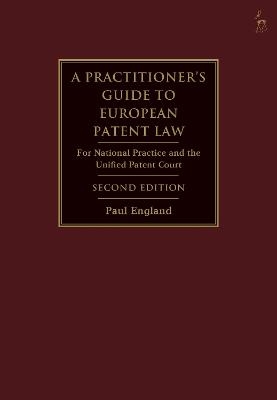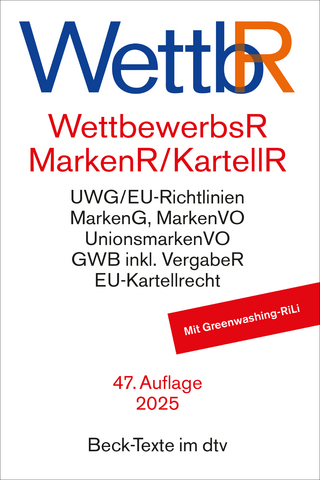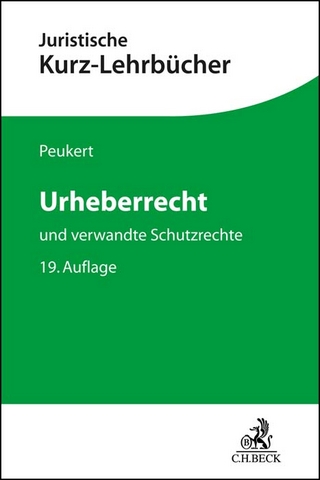
A Practitioner's Guide to European Patent Law
Hart Publishing (Verlag)
978-1-5099-4764-5 (ISBN)
Uniquely, the book addresses European patent law by subject matter area, assessing the key national and EPO approaches together rather than nation by nation. Each chapter outlines the common ground between the national approaches and provides a guide for the possible application of European patent law in national courts and the UPC in the future.
In addition to featuring content on new countries, the second edition includes new chapters dedicated to the substantive aspects of FRAND, declarations, and evidence. There is also an expanded commentary on construction, including common terms used in patent claims. A must-read for anyone working in the field of European patent law.
Paul England is a solicitor at Taylor Wessing, London, UK.
Introduction
I. Towards a ius commune of Patent Law
II. The Purpose of this Book
1. The Skilled Person and their Common General Knowledge
I. The Skilled Person or Team
II. Common General Knowledge
III. Key Issues for the UPC
2. Scope of Protection of Patent Claims
I. Statutory Basis
II. Principles of Construction
III. General Principles of National Law on the Doctrine of Equivalents
IV. The Role of the 'Formstein Defence'
V. The Role of the Prosecution File
VI. Particular Terms and Forms of Claim
VII. Numerical Ranges
VIII. Case Comparison - The Pemetrexed Decisions
IX. Key Issues for the UPC
3. Direct Infringement
I. Statutory Basis
II. Liability
III. Territoriality
IV. Product Claims (Article 25(a) CPC 1989)
V. Process Claims (Article 25(b) CPC 1989)
VI. Products Made by an Infringing Process (Article 25(c) CPC 1989)
VII. Processes for Obtaining New Products
VIII. Second Medical Use Claim Infringement
IX. Infringement of DNA Sequences
XI. Key Issues for the UPC
4. Indirect Infringement
I. Statutory Basis
II. Means Relating to an Essential Element of the Invention
III. Means Suitable for Putting the Invention into Effect
IV. Knowledge
V. Staple Commercial Products
VI. Double-territoriality
VII. Indirect Infringement of Swiss Form Claims
VIII. Other forms of Contributory Infringement
XI. Key Issues for the UPC
5. General Defences
I. The Diverse Sources of Defence to Infringement
II. The Experimental Use Exemption
III. The Bolar Exemption
IV. Other Statutory Defences
V. Exhaustion
VI. De minimis
VII. Public Interest Compulsion and Crown Use
VIII. Invalidity and Non-Infringement of Claims Asserted
IX. Issue Estoppel
X. FRAND License Objection
XI. Prior Use (Article 37 CPC 1989)
XII. Innocent Infringement as a Defence to Damages
XIII. Key Issues for the UPC
6. Declarations
I. General Jurisdictional Basis
II. Declarations of Non-Infringement
III. Declarations that a Patent is Standard Essential
IV. Declarations Concerning Validity
V. Key Issues for the UPC
7. FRAND
I. Standards, SEPs and FRAND
II. Guidance at the European Level
III. General Principles of National Law
IV. Determining the FRAND Rate
V. Anti-Suit Injunctions (ASIs) and Anti-Anti-Suit Injunctions (AASIs)
VI. Key Issues for the UPC
8. Remedies
I. Statutory Basis
II. Preliminary Injunctions
III. Damages for Unjustified Injunctions
IV. Protective Letters
V. Quia Timet Injunction
VI. Final Injunctions
VII. Springboard Relief
VIII. Award of Damages
IX. Account of Profits
X. Recall, Removing from the Channels of Commerce and Destruction
XI. Publication of Judgment
XII. Effect of Tested Validity
XIII. Substantive Treatment of Costs
XIV. Key Issues for the UPC
9. Patentability and Industrial Application
I. Statutory Basis
II. Industrial Application
III. Excluded Subject-matter
IV. Exceptions to Patentability
V. Methods of Treatment and Diagnostics – Article 53(c) EPC
VI. Key Issues for the UPC
10. Novelty
I. Statutory Basis
II. General Principles of EPO and National Case LAW
III. Treatment of Disclosure and Enablement
IV. Interpreting Patent Claims and the Prior Act for Novelty Purposes
V. Made Available to the Public
VI. Novelty over General Disclosures in the Art
VII. Priority
VIII. Product by Process Claims
IX. Second and Subsequent Medical Uses
X. Other Forms of Purpose-limited Claims
XI. Claim Amendment
XII. Key Issues for the UPC
11. Inventive Step
I. Statutory Basis
II. Date
III. Determination of Fact or Law?
IV. Technical or Commercial Question?
V. The Role of Common General Knowledge
VI. Structured Approaches to Inventive Step
VII. Motivation Based Approaches
VIII. Criticism of Problem-and-Solution
IX. Criticism of Motivation-based Tests
X. An Alternative Basis for Assessing Inventive Step
XI. Mixed Technical and Non-technical Features
XII. Combinations of Prior Art Features
XIII. Other Factors
XIV. Case Comparison (Tadalafil)
XV. Key Issues for the UPC
12. Sufficiency
I. Statutory Basis
II. General Approaches of EPO and National Law
III. Principle of General Application
IV. Technical Contribution and Invention Treated Separately
V. Forms of Claim
VI. Inventive Improvements/Infringements
VII. Promised Quality not Enabled and Errors
VIII. Deposits of Biological Material
IX. Plausibility in the Context of Insufficiency
X. Lack of Clarity
XI. Key Issues for the UPC
13. Plausibility
I. Is There a Statutory Basis?
II. Origins of Plausibility in the EPO
III. Inventive Step
IV. Insufficiency
V. Industrial Applicability
VI. The Novelty Context
VII. Post-dated Evidence and ab-initio Plausibility
VIII. The Plausibility Threshold
IX. Further Questions
X. Key Issues for the UPC
14. Supplementary Protection Certificates
I. Statutory Basis
II. Certificates for Plant Protection Products
III. Conditions for Grant
IV. Protected by a Basic Patent in Force
V. Marketing Authorisations in the SPC Context
VI. Extent of Protection (Article 4 SPC Regulation)
VII. Same Rights as Conferred by the Patent (Article 5 SPC Regulation)
VIII. Term
IX. Medicinal Products for Paediatric Use
X. The SPC Manufacturing for ex-EU
XI. Key Issues for the UPC and the Need for Reform
15. Patent Ownership, Dealings and Employee Inventors
I. Introduction
II. Ownership
III. Approaches to Inventor Compensation
IV. Right of Co-owners
V. Patent Dealings
VI. Effect of Transfer of Ownership on Licensee
VII. Compulsory Licenses
VIII. Public Interest Compulsion
IX. Unitary Patents as ‘Objects of Property’
16. Cross-border Actions in Europe
I. Relation between National and EPO Proceedings
II. The Brussels Regulation
III. Cross-border Validity Actions
IV. Cross-border Infringement Actions
V. Cross-border Declarations of Non-infringement
VI. Key Issues for the UPC
17. Evidence
I. General Principles
II. Burden of Proof
III. General Obligations to Produce Evidence
IV. Specific Means for Obtaining Evidence
V. Role of Witness of Fact Evidence
VI. Opinion Evidence
VII. Experiments
VIII. Letters Rogatory (Letters of Request) and US 1782
IX. Border Seizures
X. Confidentiality
XI. Privilege
XII. Key Issues for the UPC
| Erscheinungsdatum | 08.09.2022 |
|---|---|
| Verlagsort | Oxford |
| Sprache | englisch |
| Maße | 169 x 244 mm |
| Themenwelt | Recht / Steuern ► EU / Internationales Recht |
| Recht / Steuern ► Wirtschaftsrecht ► Urheberrecht | |
| ISBN-10 | 1-5099-4764-7 / 1509947647 |
| ISBN-13 | 978-1-5099-4764-5 / 9781509947645 |
| Zustand | Neuware |
| Haben Sie eine Frage zum Produkt? |
aus dem Bereich


